IDP News Issue No. 17
- Tibetan Manuscripts in Gansu Province, China by Sam van Schaik
- Bibliography of Catalogues of Tibetan Central Asian Manuscript Collections
- Summary of the January 2001 EPHE Vème section lecture series by Matthew Kapstein
- Ellsworth Huntington and the Central Asian Manuscripts at Yale by Sam van Schaik
- Other Resources for Tibetan Research
- Selected Publications on Tibet
- Tibetan Exhibitions
- Other Exhibitions
- Conferences
- Fieldwork Opportunities
- Publications
- Project News
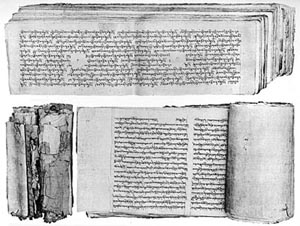
Right:Tibetan manuscripts in pothi and scroll form from the Dunhuang library cave photographed by Stein in 1907. Photograph from Serindia, 1921, vol. 4, Plate CLXXIII.
Tibetan Manuscripts from the Silk Road
Although the majority of the manuscripts found in the library cave in Dunhuang were Chinese, reflecting the fact that the Chinese empire controlled this area for much of the first millennium, there were also considerable numbers in other languages, primarily Tibetan and Uighur. This issue of the newsletter is devoted to the Tibetan manuscripts and Tibetan Silk Road art and culture.
Below, Dr van Schaik of the International Dunhuang Project reports on the Tibetan manuscripts remaining in collections in Gansu Province, China, following his research visit to Dunhuang last year. He also gives a short report on the Ellsworth Huntington collection at Yale University. There are further reports on the Songtsen Library and listings of web sites and books relating to Tibetan art and culture.
Tibetan Manuscripts in Gansu Province, China
by Sam van Schaik
A large number of manuscripts, many in Tibetan, remained in Dunhuang after Aurel Stein and Paul Pelliot had made their selections from the original cache. The Tibetan manuscripts were still there after the Chinese authorities had removed most of the Chinese manuscripts to Beijing in 1910. Subsequently a relatively small number of Tibetan manuscripts were acquired by the Otani and Oldenburg expeditions but, in 1919, a government official sent to Dunhuang reported finding 94 scroll bundles and 11 pothi volumes. The great majority of these were Tibetan. They were then removed from the cave, but their fate afterwards is little known outside China.
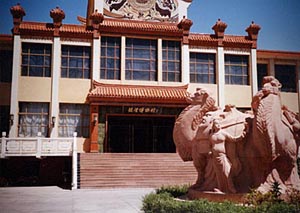
Right:The City Museum, Dunhuang
The director of the Dunhuang Academy's museum, Luo Huaqing, continues the story: 'In 1928, all the Tibetan manuscripts remaining in Dunhuang went to a cultural institute in Dunhuang city. After 1949, some were brought to the Dunhuang Academy, some were sent to provincial museums, but most of the manuscripts were placed in the City Museum of Dunhuang.'
The present whereabouts of the manuscripts
In a 1978 article by Huang Wenhuan was published on the whereabouts of the Dunhuang Tibetan manuscripts in Gansu province (Wenwu (Dec. 1978), pp. 59-63). He reported that small collections of Tibetan manuscripts were held in the county museums of Jiuquan, Zhangye and Wuwei, that the Dunhuang Academy held 42 pothi folios and 43 scrolls, and that Lanzhou Library held 1,117 folios and 30 scrolls. Most significantly, he reported that Dunhuang City Museum held 8,780 Tibetan folios and 224 scrolls.
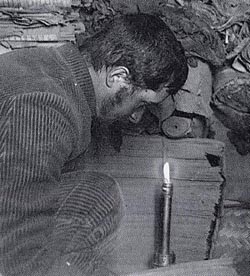
Left:Detail of a photograph of Paul Pelliot in the library cave. Behind Pelliot a stack of large pothi leaves can be seen.
In July 2000 I had the opportunity to visit Dunhuang on a British Academy funded research trip. At the Dunhuang Academy I was shown their collection of 47 scrolls (as well as one single panel and one fragment), all of which, except one, contained the Tibetan text of the Aparimitayurnamasutra (the exception was the Heart Sutra). There were 87 large pothi leaves, all containing the Tibetan text of the Prajnaparamitasutra in 100,000 verses.
Additionally, the Academy holds at least 700 more Tibetan pothi leaves, and numerous fragments, but all are apparently not older than the Yuan period and some are certainly more recent than that. I also visited the Dunhuang City Museum. The scrolls which I examined all contained, once again, the text of the Aparimitayurnamasutra, while the pothi leaves were all of the large variety, again with the text of the Prajnaparamitasutra in 100,000 verses. According to the museum's curators, the other folios, which they confirmed were over 8,000 in number, were all of the same format.

Right:A scroll at the Dunhuang Academy
The significance of the Chinese collections
The group of Tibetan manuscripts in the Dunhuang City Museum makes it the third largest collection in the world, after those of Paris and London. Furthermore, the manuscripts in the Dunhuang Academy and Lanzhou Library comprise significant smaller collections. However, while the size of the Gansu collections rivals those of the Paris and London, the manuscripts are much less varied in subject matter. It seems that both Stein and Pelliot, through a combination of circumstances, took away with them the most varied of the Tibetan manuscripts, leaving behind mainly those regular sets of manuscripts stored together in scroll bundles and large pothi volumes.
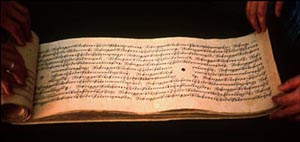
Left:Rolled Pothi sheets at the Dunhuang Academy
Outside Gansu, other institutions in China also have small collections of Dunhuang Tibetan manuscripts. The National Library of China in Beijing holds around 200 manuscripts which may have arrived in Beijing in 1910 along with the Chinese scrolls. Peking University Library, Shanghai Library, Shanghai Museum, and Tianjin Arts Museum each have a few manuscripts. Peking University Library acquired most of its Tibetan manuscripts in the 1950s from collectors, and this is likely to be the case with the other institutions too.
I would like to thank The British Academy, who provided me with a grant to travel to China, as well as Fan Jinshi and Luo Huaquan at the Dunhuang Academy and Sun Liping at the National Library of China who helped me during my visit.
Bibliography of Catalogues of Tibetan Central Asian Manuscript Collections
de la Vallée Poussin, Louis, Catalogue of the Tibetan Manuscripts From Tun-Huang in the India Office Library, Oxford University Press, 1962.
Yamaguchi, Z., Kimura, R., Harada, S, Nishioka, S, Uesugi, R. (edd.), Sutain Shushu Chibetto-go Bunken Kaidai Mokuroku (A Catalogue of the Tibetan Manuscripts Collected by Sir Aurel Stein), 12 vols., The Toyo Bunko, Tokyo, 1977-1988.
Thomas, F. W., Tibetan Literary Texts and Documents concerning Chinese Turkestan, Part II: Documents, Royal Asiatic Society, London, 1951.
Takeuchi, Tsuguhito, Old Tibetan Manuscripts from East Turkestan in the Stein Collection of the British Library (3 vols.), The Centre for East Asian Cultural Studies for Unesco, The Toyo Bunko & The British Library Board, 1997-2000.
Lalou, Marcelle, Inventaire des manuscrits tibétains de Touen-houang conservés À la Bibliothèque Nationale (Fonds Pelliot tibétain), 3 vols., Bibliothèque nationale, Paris, 1939-1961.
Savitsky, L.S., Opisanie tibetiskikh svitkov iz dunkhuana v sobranii instituta vostokovedeniia an SSSR, Moscow, 1991. Taube, Manfred, Die Tibetica der Berliner Turfansammlung. Akademie-Verlag, Berlin, 1980.
'La formation du Bouddhism tibétain À travers les documents de Dunhuang'
Summary of the January 2001 EPHE Vème Section Lecture Series
Matthew Kapstein
The four lectures in the series concerned primarily two broad themes: relations between Tibetan and Chinese Buddhism under the Tibetan empire during the early 9th century; and aspects of the development of Tibetan Buddhist tantrism during the early post-imperial period (late 9th and 10th centuries).
The study of Sino-Tibetan religious relations has so far generally emphasized the transmission to Tibet of Chan Buddhism, and the controversy surrounding it. It has been primarily in the work of the late R.A. Stein that other aspects of the relationship have been to some extent examined, for instance, the spread of Chinese Buddhist apocryphal literature in Tibet. In the first lecture, 'Mulian au pays des neiges: les traditions chinoises de l'arhat Maudgalyayana dans la littérature Tibétaine', we have sought to add to this line of research.
The elaboration of the legend of the Arhat Maudgalyayana during the course of Buddhism's progression from India through Central Asia to China has been a topic that has long fascinated scholars of Chinese literature and of Buddhism in East Asia. Two of the most famous products of the legend's development are the Yulanpen jing (Taisho 685) and the Da muqianlian mingjian jiumu bianwen, often referred to in English as The Transformation Text on Mulian Saving His Mother from Hell. It can now be established that these works were to some extent known in Tibet, where they exerted a degree of influence on later Tibetan Buddhist literary accounts of the life of the Buddha and his disciples.
The Tibetan version of the Yulanpen jing is so far known from just three of the manuscript versions of the Tibetan Buddhist canon, where it is entitled 'Phags pa yongs su skyobs pa'i snod ces bya ba'i mdo (Stog Palace Kanjur no. 266, Ulan Bator 314 and Tokyo 266); it is not found in the printed editions. According to the colophon it was translated from the Chinese by 'Gos Chos-grub, the renowned ninth century translator based in Dunhuang, who is also well-known in Chinese as Facheng. The translation is literal and precise, and corresponds very closely with the published Chinese version of the Yulanpen jing, as found in the Taisho Tripitaka (no. 685).
It is of considerable interest, too, that in the Stein collection of Tibetan documents from Dunhuang in London, we find a short verse text composed by 'Gos Chos-grub himself that is devoted to the story of Maudgalyayana (de la Vallée-Poussin 1962, no. 686, IOL Tib J 686). This work is based not on the Yulanpen jing, but on the Transformation Text. Besides this, the Transformation Text had a considerable legacy in later Tibetan literature and a fuller version of it was also translated into Tibetan. Among the numerous late retellings of the tale, we have considered here the version given the popular life of the Buddha (Sangs-rgyas mdzad-rnam) authored by Sna-nam btsun-pa Skal-bzang-chos-kyi-rgya-mtsho (15th century), and the Dmyal-gling episode of the epic of Gling Ge-sar, which seems certainly to be derived ultimately from the story of Mulian's mission to rescue his mother from hell.
The second lecture, 'L'identification du temple de De ga g.yu tshal: étude iconographique', concerned the problem of the precise location of the 'temple of the treaty' (gtsigs kyi gtsug lag khang) celebrated in the Tibetan Dunhuang manuscripts Pelliot Tibétain 16 and IOL Tib J 751, first studied by F.W. Thomas. The temple had been founded to commemorate the treaty of peace concluded between Tibet, China, the Uighurs and the kingdom of Nanzhao in 821. Though the exact significance of de ga in the name of place where the temple was situated remains uncertain (it is perhaps an ancient local geonym), philological arguments were advanced to show that g.yu tshal might have stood for the Chinese place name Yulin, though it is neither an exact translation or transcription of the latter. The suggestion that g.yu tshal = Yulin is however strengthened by the study of iconographic information contained in PT 16: this is found to closely match the actual iconography of Anxi Yulin cave 25, a temple already famed among art historians for the exceptional refinement of its murals. Its construction dates certainly to the period of Tibetan administration in the region during the early 9th century. In its overall iconographic program, as well as in the style of its execution, this temple clearly seems to mediate between Tibetan and Chinese religious worlds, and thus would have been a fitting monument to an accord between these two powers.
The last two lectures both sought to illustrate the early formation of the tantric traditions of Rnying ma pa order, with reference to a particular cycle belonging to the Rnying ma bka' ma collections, namely, the Na rak dong sprugs ('Stirring up the hells'). In the first, 'En amont de la tradition Rnying ma pa: 1. le lotus aux cent pétales: un mandala tantrique', we have studied IOL Tib J 318, a Tibetan manuscript from the Stein collection describing a lotus-mandala of 108 divinities. The mandala in question certainly is derived from the Yogatantras and probably from the Sarvadurgatiparisodhanatantra in particular. Nevertheless, we have attempted to suggest that it may also be related to the mandala called padma brgya-ldan, the 'hundred-petalled lotus', that is the special mandala of the Na rak dong sprugs cycle, and that is attested in Rnying ma pa historical cources as an icon in the temples of the Zur lineage. A functional relationship with the Sarvadurgatiparisodhanatantra is further suggested by a common emphasis on the purification of evil karma and miserable rebirth.
It is in any case quite certain that elements belonging to the Na rak dong sprugs cycle are already in evidence in the Dunhuang Tibetan documents. The final lecture, 'En amont de la tradition Rnying ma pa: 2. un rite de contrition tantrique', concerned a clear example, IOL Tib J 584, a brief tantric confessional litany. We have been able to demonstrate that most of the content of the text can be matched, word for word, with passages contained in a Rnying ma tantra that has remained unstudied to date, the Dri med bshags rgyud, the tantra, in fact, from which the Na rak dong sprugs cycle is derived.
Matthew Kapstein is Associate Professor of Tibetan and Buddhist Studies, Department of South Asian Languages and Civilizations, The University of Chicago.
Ellsworth Huntington and the Central Asian Manuscripts at Yale
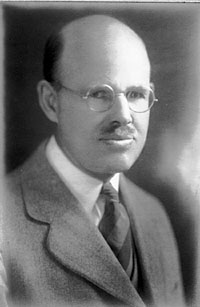
Ellsworth Huntington (1876-1947) was perhaps the best known American geographer of his time. In the last forty years of his life he was a lecturer and research associate at Yale University, during which time he pursued his great interest, the effect of climate changes on human culture and civilisation.
Before he arrived at Yale, Huntington also had a short career as one of the first Central Asian explorers. He accompanied an expedition led by Raphael Pumpelly in 1903-1904, which spent most of its time in Russian Turkestan (as it was then), north-west of the Taklamakan Desert. In 1905-06 he accompanied an expedition led by Robert Barrett into Chinese Turkestan, travelling over the Himalayas to Khotan and Niya. Setting out in a different direction from Barrett, Huntington travelled east from Niya to the Lop Nor desert, then north to Turfan, and travelled home via Siberia and Russia.
Huntington drew on his Central Asian experiences to illustrate his theory of the significant effect of climatic change on civilisations in his book The Pulse of Asia (Houghton Mifflin, Boston, 1907). He concluded that: 'with every throb of the climatic pulse which we have felt in Central Asia, the centre of civilisation has moved this way and that. Each throb has sent pain and decay to the lands whose day was done, life and vigour to those whose day was yet to be.'
Although Huntington was not an archaeologist, he brought back a few souvenirs from his Central Asian journeys, manuscripts and artifacts, which were acquired by Yale University Library after his death. This small collection includes some fragments of scuplture, probably from one of the sites on the southern Silk Road, and manuscripts on paper and wood. These include a portion of the Saddharmapundarikasutra in Sanskrit, a page from The Book of Zambasta in Khotanese, and wooden slips with Kharosthi, Khotanese and Tibetan inscriptions.
Huntington was not a textual scholar, but he was able to enlist the help of F.W. Thomas, a retired India Office librarian and scholar living in Oxfordshire, who catalogued the Kharosthi and Tibetan wooden slips. Most of Thomas's transcriptions were published and, more recently, scholars including R.E. Emmerick and Akira Yuyama have published studies of the other manuscripts in the Huntington collection.
Bibliography
Studies of Manuscripts in the Huntington Collection
Boyer, A. M., E. J. Rapson, and E. Senart, Kharosthi Inscriptions Discovered by Sir Aurel Stein in Chinese Turkestan, vol.3., Clarendon Press, Oxford, 1929. (F. W. Thomas's work on the Kharosthi wooden slips is on pp. 283-285.)
Emmerick, R. E., The Book of Zambasta: A Khotanese Poem on Buddhism, Oxford University Press, London, 1968. (The Khotanese folio of The Book of Zambasta, pp. xii, 120.)
Thomas, F. W., Tibetan Literary Texts and Documents Concerning Chinese Turkestan, Part II: Documents, The Royal Asiatic Society, London, 1951. (For the Tibetan wooden slips see pp. 199-200, 216, 465.)
Yuyama, Akira and Hirohumi Toda, 'The Huntington Fragment F of the Saddharma-pundharika-sutra', Studia Philologica Buddhica, Occasional Paper Series, Tokyo, 1977.
Expedition Reports
Huntington, Ellsworth, The Pulse of Asia: A Journey in Central Asia Illuminating the Geographic Basis of History, Archibald Constable and Co., London, 1907.
Pumpelly, Raphael (ed.), Explorations in Turkestan: Expedition of 1904, The Carnegie Institute of Washington, Washington D.C., 1908.
Sam van Schaik, IDP, The British Library.
Many thanks to Dr Jonathan Silk for his help at Yale, and to Annette Demming for providing the picture of Ellsworth Huntinton.
Other Resources for Tibetan Research
The Songtsen Library
The Songtsen Library is an International research library whose goal is to make accessible in one place (digitally or otherwise) the extant and diverse primary and secondary sources dedicated to Himalayan culture and history. The special emphasis of the Songtsen Library is the complete Dunhuang collected Tibetan manuscripts as well as the study and preservation of the history of Tibetan and Himalayan culture.
The library will also have significant holdings on all traditions of Buddhism furthering the study of Buddhist scripture and scholarship.
The library will use state-of-the-art computer technology bringing online an integrated catalogue and index, unifying search and query of local and international databases for all extant sources of information.
For more information, contact:
Michael Thompson
Songtsen Library
P.O. Kulhan, Sahastradhara Road
Dehra Dun (U.A.) 248001 India
Tibetan Studies Library
This is a new series by Brill Academic Publishers and is intended to provide a forum for outstanding works concerning the Tibetan cultural region, aimed at 2-3 titles per annum. The first volume is expected in November 2001.
For details see:
http://www.brill.nlCircle of Tibetan and Himalayan Studies
London, UK
The aim of this newly formed circle is to encourage the scholarly exploration of Tibetan culture by providing a forum for research, exhibitions and affiliated events in the UK.
For further details contact:
Dr Ulrich Pagel
Department of the Study of Religions
SOAS, Russell Square
LONDON WC1H OXG, UK
tel: +44 20 7898 4782
fax: +44 20 7898 4779
email: cths@soas.ac.uk
Selected Publications on Tibet
Websites
http://www.ciolek.com/WWWVL-TibetanStudies.html
Matthew Ciolek's guide to other sites on Tibet and Tibetan studies.
Buddhist Texts
Tibetan Buddhism Resource Centre
http://www.tbrc.org
An extensive searchable catalogue of Tibetan texts and authors, with some texts
available online.
The Asian Classics Input Project (ACIP)
http://www.asianclassics.org
Texts available for download, including Tibetan texts from the Kanjur, Tenjur and other sources, as well as catalogues of certain library collections.
The Samantabhadra Collection
http://jefferson.village.virginia.edu/tibet/
A catalogue of the canonical collections of the Nyingma school.
Art
The Rubin collection
www.himalayanart.com
Online images of hundreds of paintings from the Rubin collection of Tibetan and Nepalese art.

Art Books
A History of Tibetan Painting, David Jackson
Verlag der österreichischen Akademie der Wissenschaften, 1996
Tibetan Painted Scrolls, Guiseppe Tucci
Libreria della Stato, Rome, 1949, reprinted in a limited edition of 500 copies by SDI Publications, Thailand, 1999
Tibetan Thangka Painting, David Jackson & Janice Jackson
Serindia Publications, London, 1984
Buddhist Symbols in Tibetan Culture, Loden Sherab & Dagyab Rinpoche
Wisdom Publications, 1995
The Encyclopedia of Tibetan Symbols and Motifs, Robert Beer
Serindia Publications, London, 1994
Recent Publications
The Dalai Lama's Secret Temple, Ian Baker, et. al.
Thames and Hudson, London, 2000
Photographs of the murals of the Lukhang temple in Lhasa.
Ruthless Compassion, Rob Linrothe
Serindia Publications, London, 1999
A study of the deptition of wrathful deities in Tibet.
From the Sacred Realm, Valrae Reynolds et al.
Prestel, Munich and New York, 1999
Catalogue of the 1999-2000 exhibition held at Newark Museum, New Jersey.
Sacred Visions, Steven M. Mossak and Jane Casey Singer
Harry N. Abrams, Inc., NY, 1998
Catalogue of the 1998 exhibition at the Metropolitan Museum of Art, New York.
The Sculptural Heritage of Tibet, David Weldon, and Jane Casey Singer
Laurence King Publishing, London, 1999
Catalogue of the 1999 exhibition at the Ashmolean Musueum, Oxford.
Tibetan Art, Amy Heller
Antique Collectors' Club, London, 1999
An introduction to Tibetan art.
Worlds of Transformation, Marylin Rhie, Robert Thurman & David Jackson
Harry N. Abrams, Inc., New York, 1999
Paintings from the New York collection of Shelley and Donald Rubin.
List compiled by Sam van Schaik
Tibetan Exhibitions
THE GODS OF THE HIMALAYAS Essen Collection of Tibetan Art
Opening 6 May, 2001
Museum der Kulerten
Basel, Switzerland
Thanks to a generous donation in 1998, the Museum der Kulturen Basel now possesses one of the world's most important collections of Tibetan art. It was compiled by the religion scientist Gerd-Wolfgang Essen in Hamburg. During his thirty years of research, Essen not only collected two hundred thangkas and religious statues, but also ritual utensils, books, masks, musical instruments, temple textiles and furniture. Thus, this unique collection today provides us with an impressive picture of the religious culture of Tibetan Buddhism.
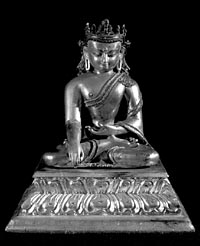
Right:Jowo Rinpoche Sculpture, fire-gilded hollow copper casting, height: 23.5 cm, Tibet, 16th century IId 13889 (Essen I-1)
TIBET - BUDDHAS - GODS - SAINTS Museum der Kulturen Basel, Switzerland
7 May to 31 October, 2001
Augustinergasse 2, CH-4051 Basel
Opening hours:
Tues. - Sun. 10 am - 5 pm
Wed. 10 am - 9 pm
Special opening: Mon., May 7, 10 am - 5 pm
Closed on Mondays, closed on August 1st
For details see:
http://www.mkb.ch
For further information please contact:
Mrs Anna-M. Stalder, Press officer
Tel: +41 61-266 56 34
Email: anna-margaretha.stalder@bs.ch
TIBETAN TANGKAS
2001 Touring Exhibition in Japan
Tokyo, Fukuoka, Kyoto and two other cities
The Hanh Cultural Foundation is located in Seoul, Korea and houses the largest Tibetan Thangka collection - over 1200 paintings - in East Asia. They also run the Hwajeong Museum. A selection of Tibetan Thangkas from the collection is currently on exhibition tour in Japan.
For details see:
http://home.interlink.or.jp/~aom
Other Exhibitions

L'ASIE DES STEPPES D'ALEXANDRE LE GRAND À GENGIS KHAN
Musèe des Arts asiatiques-Guimet, Paris, France
3 February - 2 April, 2001Madrid
25 April - 1 July, 2001
This exhibition, to coincide with the reopening of the Musèe Guimet, comprises 180 works dating from the time of Alexander the Great (356-323 BC) to Genghis Khan (1176-1227). A catalogue in French is available.
For details see:
http://www.museeguimet.fr
BORNE OF THE EAST WIND: ORIENTAL ART FROM PRIVATE COLLECTIONS IN FINLAND
Amos Anderson Art Museum, Helsinki, Finland
1 March - 29 April, 2001
This exhibition comprises 205 works of art, including paintings and statues, with the primary focus on Central Asia.
A catalogue with preface and captions in English is available.
For details see:
http://www.amosanderson.fi
Thanks to Alpo Ratia for details of this exhibition.
MUSEUM FüR INDISCHE KUNST
Berlin-Dahlem, Germany
The Museum für Indische Kunst reopened on 20 October 2000 after several years' restoration. One gallery and a corridor are devoted to the finds from Central Asia which include many mural fragments from the caves at Bezeklik and Kizil. Cave 123 from Kizil has been recreated in the centre of the gallery. Textual fragments, painted banners, paintings and sculptures from central Asian sites are also displayed.
Conferences
2001 INTERNATIONAL TURFANOLOGICAL CONFERENCE
Turfan, China
15-20 August, 2001
For details contact:
Ouyang Hui
Turfan Bureau of Cultural Relics
26 Gaochang Road
Turfan, Xinjiang, China
Tel: +86 995 8522619
Email:OuYangHui@Email.com.cn
'A MAN SHOULD NOT ACT DIFFERENT FROM HIS WIFE:
THE ROLE OF WOMEN IN THE ALTAIC WORLD'
Permanent International Altaistic Conference
PIAC 44th Meeting
Walberberg, Germany
26-31 August, 2001
For details contact:
Secretary General, PIAC
Goodbody Hall 157
Indiana University
1011 E. Third St.
Bloomington
Indiana 47405-7005, USA
Fax: +1 812 855 7500
Email: sinord@indiana.edu
TURFAN REVISITED: THE FIRST CENTURY OF RESEARCH
INTO THE ARTS AND CULTURES OF THE SILK ROAD
Berlin, Germany
8-15 September, 2002
This conference will conincide with a major international exhibition at the Museum of Indian Art in Berlin-Dahlem, details of which will be given in a future issue.
For details contact:
Professor Dr Werner Sundermann
Akademienvorhaben Turfanforschung Berlin-Brandenburgishce
Akademie der Wissenschaften
Unter den Linden 6
D-10117 Berlin, Germany
Tel: +49 30 20370 472
Fax:+49 30 20370 467
Email:sundermann@bbaw.de
INTERNATIONAL DUNHUANG STUDIES IN THE 21ST CENTURY:
CONFERENCE IN HONOUR OF PAN ZHONGGUI'S 95TH BIRTHDAY
Chung Cheng University, Jiayi, Taiwan
2-4 November, 2001
For details contact:
Organizing Committee
International Dunhuang Studies in the 21st Century
Chinese Literature Department
National Chong Cheng University
160 Sanhsing Tsun, Minhsiung
Chiayi Hsien, TAIWAN
Tel: +886 5 2720411
Fax: +886 5 2720493
Email: chlacc@ccunix.ccu.edu.tw
Fieldwork Opportunities
ARCHAEOLOGY IN WESTERN UZBEKISTAN (ANCIENT CHORASMIA)
The University of Sydney Central Asian Programme (USCAP) invites volunteers to join them on their current excavations in western Uzbekistan (ancient Chorasmia). The trip is organised as a tour, with two weeks spent with the field team excavating a massive fortified city datting to around the 4th century to 2nd century AD and a fire temple complex of roughly the same date. The visitors will then continue to a tour of the Silk Road cities of Khiva, Bukhara and Samarkand.
There are two group departures, each of about 12 people. 3 and 17 Sept. ex-Sydney. You may also join the tour in Tashkent (land-only price available on request). A shorter tour takes place in May/June. This replaces the excavation with a five day study tour of the early frontier fortresses of Chorasmia.
Details can be obtained from our website at:
http://members.spree.com/education/uscap/uscap/htm
You may also email the Project Director, Dr Alison Betts at:
alison.betts@archaeology.usyd.edu.au
SUMMER ARCHAEOLOGY IN SOUTHERN RUSSIA AT THE CHASTIYE KURGANS
The Center for the Study of Eurasian Nomads is now taking applications for the above. Information on the archaeological site, the leaders of the expedition, dates of the session, and other pertinent information is available on the CSEN website at:
http//:www.csen.org
or directly on the Chastiye Kurgans Information page at:
http://csen.org/2001%20Chastiye%20Kurgans/Chastiye%20Kurgans.html
Please address any questions to:
Dr. Jeannine Davis-Kimball
Executive Director
Center for the Study of Eurasian Nomads
577 San Clement St.
Ventura, CA 93001 USA
Tel. & fax: +1 805 653-2607
Publications
Buddhist Manuscripts in the Schoyen Collection, Vol. 1, Jens Braarvig,
Jens-Uwe Hartmann, Kazunobu Matsuda, Lore Sander (edd.)
Hermes Academic Publishing and Bookshop, Oslo, 2000, ISBN 8280340017.
NOK880/USD95.
For details contact:
Postboks 2709 Solli, N-0204 Oslo Tel & Fax: +47 22 43 69 95
Email: hermesac@online.no
In Japan contact:
Malshow Co. Ltd. Book Section
c/o Mistubori, 2-24 Fujimi-cho,
Yokosuka 238-0021, Japan
Email: malsho@beige.ocn.ne.jp
For details of the Schoyen collection see: http://www.nb.no/baser/schoyen/
Legacy of the Desert King: Textiles and Treasures from Niya on the Silk Road, Feng Zhao and Zhiyong Yu (edd.)
ISAT/Costume, Hong Kong, 2000, 112 pp., colour ills., Chinese/English bilingual, USD20
Catalogue of the exhibition held at Hangzhou, China from 20 October.
The ancient site of Niya is located in the southwestern area of the Taklamakan Desert. It was first excavated by Stein in 1901 and, from 1988, a Sino-Japanese team have been carrying out fieldwork there.
For details contact:
Feng Zhao
China National Silk Museum
73-1 Yuhuangshan Rd
Hangzhou310002, China
Fax: 86-571-7068136
Tel: 86-571-7068138
Email:zhaofeng38@hotmail.com or zhaofeng@hz.col.com.cn
The Renovation of the Musée Guimet: Towards a New Understanding of Asian Art in Paris, Jean-Francois Jarrige, Directeur.
This is one of the world's premier collections of Asian art and the article is an informative history of the museum and its collections with some stunning photographs of the renovated interior and of its exhibits. The museum had its official reopening in January 2001.
Anyone wishing to purchase reprints of this article should contact the publisher:
Arts of Asia Publications Ltd.
1309 Kowloon Centre, 29-39 Ashley Rd
Kowloon, Hong Kong
Tel: +852 2376 2228
Fax: +852 2376 3713
Email: info@artsofasianet.com
L'Asie des Steppe d'Alexandre le Grand À Gengis Khan,
Reunion des Musées Nationaux and Fundacio'La Caxia',
Paris and Barcelona, 2000. ISBN 27112841766, FF290.
Catalogue of an exhibition held in Madrid, Paris and Barcelona, 2000-2001 (see above).
History of Civilizations of Central Asia. Vol. IV. The Age of Achievement: A.D. 750 to the end of the fifteenth century. Part 2: The Achievements, C. E. Bosworth and M. S. Asimov (edd.)
UNESCO Publishing, 2000. ISBN 92-3-103654-8. 300 Ffr plus 30 Ffr postage (total, 50.30 euros).
http://www.unesco.org
The first volumes of this series have recently been reprinted in India, but they are also still available from UNESCO in Paris.
Southern Silk Road: In the Footsteps of Sir Aurel Stein and Sven Hedin, Christoph Baumer
Orchid Press, Bangkok, 2000. 166pp., ISBN: 9748304388 (hb), 9748304396 (pb),
USD45 (hb), USD35(pb).
To order contact:
Asia email: wop@inet.co.th
US fax: +1514-934-6043
Europe fax: +7 22 56 57 66
Silk Road on Wheels, Akhil Bakshi, Odyssey Books, 2001. USD19.95.
For details:
http://www.cuvlindia.com/odessy/silkroute.htm
Journals
Bulletin of the Asia Institute, 11 (1999), pub. Nov. 2000
For details contact:
3287 Bradway Blvd., Bloomfield Hills
MI 48301, USA
Tel: +1 248 647 7917
Fax: +1 248 647 9223
Email:bai34@aol.com
http://www.bulletinasiainstitute.org
Asia Major, 3rd series, 11, 2 (1998), pub. 2000
Institute of History and Philology, Academia Sinica, Taipei
Devoted to papers from the 'Third Silk Road Conference' held in July 1998 at Yale University, USA.
Project News
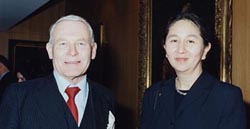
Left:Professor Naylor, Chairman of the Sino-British Fellowship Trust (SBFT), and Jannette Cheong, Head of International Collaboration and Development
Joint Project with the National Library of China
A memorandum of Understanding for a five year project between the British Library and the he National Library of China concerning the International Dunhuang Project was signed on 7 March by Lynne Brindley, Chief Executive of the British Library, in the presence of H.E. Ma Zhenguang, Chinese Ambassador to the UK. Zhou Heping, Deputy Director of the National Library of China, was signatory for the Chinese side.
The reception was also attended by representatives of the two main project sponsors, Professor Naylor, Chairman of the Sino-British Fellowship Trust (SBFT), and Jannette Cheong, Head of International Collaboration and Development, The Higher Education Funding Council for England (HEFCE) (pictured left). Full details of this exciting collaboration will be given in the next issue of IDP News.

Right:HE Ma Zhenguang, Chinese Ambassador to the UK, with Lynne Brindley, Chief Executive of The British Library, siging the agreement with the National Library of China.
The Mellon International Dunhuang Archive
In December 2000 the Andrew W. Mellon Foundation agreed to make an award of $1.1 million to the British Library for the Mellon International Dunhuang Archive (MIDA), a scholarly resource that the BL is taking a leading role in developing. The Archive will include two and three-dimensional images of the Dunhuang Buddhist caves linked with digital images of a selection of the artefacts and manuscripts found at Dunhuang. The Archive will complement the International Dunhuang Project web database which will continue to work towards digitizing all of the first millennium manuscripts and documents found at Dunhuang and other Silk Road sites and now in collections worldwide and making them freely available to all on the Internet.
Over the next four years, as part of the Mellon funded project, IDP will digitise over 4,000 manuscripts comprising 35,000 images using the latest digital cameras. As part of this project, advertisements were placed for six new IDP staff, included a Administrative Manager, 3 photographers and 2 Imaging Assistants. Full details of the new IDP personnel and progress on this project will be given in the next issue.
People
Susan Whitfield attended the ECAI conference held at the City University of Hong Kong in January, 2001. She also gave several talks in Hong Kong on the project.
Dr Ksenia Kepping from the Institute of Oriental Studies, St. Petersburg, arrived in London for a three month visit to catalogue the Tangut (Xixia) manuscripts from Kharakhoto, funded by the UK National Heritage Memorial Fund. An article by Dr Kepping will appear in the next issue. Two new imaging consultants started work with the IDP team during January, working on Tibetan and Chinese fragments respectively.
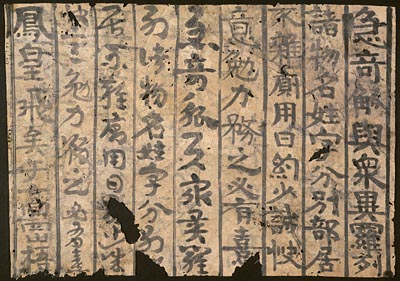
Conservation
Right:Stein fragments Or.8212/480-484 (Maspero Nos. 169-173) reunited as one document.
Anna-Grethe Rischel visited the library in December to give a report on her research into the paper fibres of the fragments from Loulan both in the Hedin and Stein collections. She has been working closely with Japanese colleagues on these fragments and the results will be published later this year.
Conservation was carried out at the British Library on the particular Loulan fragments under investigation, and they were rejoined (see right). It is curious that these fragments, which clearly belong together, were found by Stein at different sites in the Loulan area, some several miles apart.
Electronic Publication
IDP was submitted as one of the first electronic publications of the California Digital Library/Electronic Cultural Atlas Initiative collaboration. Details will shortly be available on www.ecai.org.
